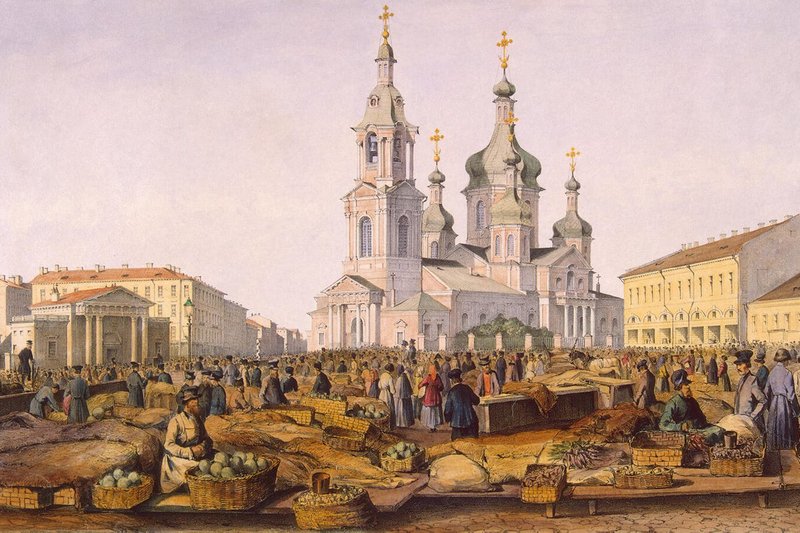St. Petersburg in the era of Nicholas I (1825-1855)
At the beginning of Nicholas's reign, the centre of St. Petersburg was being ornamented for the ages with a series of grand and imposing compositions of buildings in the Empire style, with its "ideal" proportions and monumental classical forms. By the close of his reign thirty years later, picturesque eclecticism (a fanciful mix of various historical styles) held sway unchallenged and the Russian Revival style, which with its fussy medieval forms and gaudy fairytale decorations was the direct antithesis of classical purity, was coming into vogue.

Many grandiose architectural ensembles appeared in the city during the era of Nicholas I. The Alexander Column, the completion of the General Staff Building, and the construction of the Guards Corps headquarters completed the breathtaking panorama of Palace Square. The Senate and Synod Building on Senatskaya Ploshchad provided a suitably grand backdrop for the Bronze Horseman. Concurrently, the magnificent neo-classical ensemble consisting of the Alexander Theatre, the Imperial Public Library and Ulitsa Zodchego Rossi ("Architect Rossi Street") was built. The last of these was originally Teatralnaya Ulitsa ("Theatre Street"), but was renamed in 1923 in honor of Carlo Rossi, the extraordinarily talented Italian architect and planner who oversaw every one of these projects.
As strict classicism faded from fashion, a new generation of architects began to adapt classical forms by making free use of decorative elements from previous eras while employing the most innovative materials. In Petersburg, the Mariinsky and Nikolaevsky Palaces were built for the children of Nicholas I according to the plans of architect Andrey Stakenschneider, and on Znamenaya Ploshchad (now Ploshchad Vosstaniya) the Moskovsky Railway Station was constructed by Konstantin Ton. It is still used today by hordes of commuters and travellers daily. On Millionnaya Ulitsa, the German architect Leo von Klenze designed the New Hermitage building, in which for the first time, the Hermitage's collections were made accessible to the general public. Nicholas himself participated in the organization of the exhibits. Anichkov Bridge, sporting its four impressive Horse Tamer sculptures by Peter Klodt, was unveiled. And throughout Nicholas's reign, work continued on St. Isaac's Cathedral, which was still only nearing completion when the Tsar died in 1855.
Despite the autocracy and strict censorship that characterized his rule, Nicholas's reign also witnessed the apogee of the "Golden Age" of Russian literature and culture in general. St. Petersburg was both the inspiration and the main audience for Alexander Pushkin's long narrative poems and the darkly comic tales of Nikolay Gogol, and both authors laid the foundation stones for the "literary city" of St. Petersburg, a richly ambiguous urban presence that runs through the Russian literary canon to this day. In classical music, meanwhile, Mikhail Glinka became the first prominent Russian composer, beginning the great tradition of Russian opera and, as Nicholas's reign progressed, the Imperial Theatres cemented their position as a centre of excellent in ballet through the work of the great choreographers Charles-Louis Didelot, Jules Perrot and, at the very start of his glorious career, Marius Petipa.
The Industrial Revolution finally came to Russia in earnest. Under Nicholas I, railroad construction began, and in 1837, the country's first railroad was built between Petersburg and the Imperial residence in Tsarskoye Selo. By 1851, the strategically important Nikolaevsky Railway, connecting Petersburg with Moscow, was finished. And the first permanent bridge across the Neva was constructed, also bearing the name Nikolaevsky (today Annunciation Bridge). Until that point, only pontoon bridges had been used.

Nicholas I is honored in an equestrian created by Peter Klodt and Auguste de Montferrand, designer of St. Isaac's Cathedral, and placed on St. Isaac's Square in the heart of St. Petersburg.






